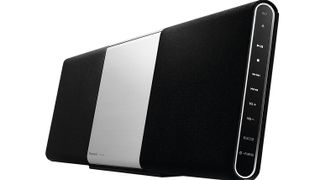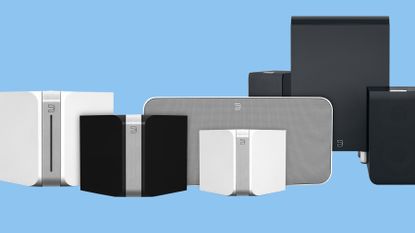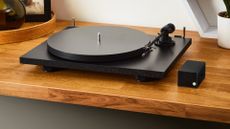From the proliferation of online music services like Tidal and Spotify, to the explosion of Bluetooth speakers and media streamers, we're clearly heading for a wireless world where our music and movies simply arrive on the nearest screen or speaker to hand.
So as multi-room manufacturers do what they can as fast as they can to keep up with the media, what is it that we're all heading for in such a hurry?
Quality vs Quantity0
The good news is that where there's competition, there's innovation, and with Apple now wading into the music-streaming fray, Spotify et al are already starting to up their game. Apple's enormous existing user base (or should that be fan base?), gives Beats 1 a signifi cant head start in the numbers war, and its back catalogue can only be described as considerable. But if the battle is being fought in terms of quality not quantity, sites like Tidal and Qobuz have the stronger case because, unlike Beats 1, they both offer tracks in much sought after high resolution.
This is, quite literally, music to the ears of anyone searching for the best-quality sound. High-res audio has been around for over a decade now, but it's no longer the preserve of audiophile anoraks alone. As a differentiator between compressed MP3 music and lossless 'studio master quality' files, it's fast becoming a powerful marketing tool for manufacturers. Audio has been left behind in the escalating pixel wars that have led so quickly to 4K resolution television. Could this be the music industry's high definition moment?
There are plenty of hardware companies and music services that think exactly that. High-res music, with its bloated FLAC and WAV fi les, was not welcome on Apple's iPod or any of the early online music services, and it's still no friend to much of the new wave of media-streaming hardware. But now that memory is cheap and bandwidth is broadening, albeit at a slower pace, high-resolution audio has fi nally found a footing. You may well have noticed the gold seal, the Hi-Res Audio logo first toted by Sony, appearing on more and more hardware as manufacturers and consumers begin to see it as a mark of quality.
Supporting acts
As the original innovator of the wireless scene, it was Sonos that disrupted the cosy hard-wired multi-room industry that was at one time ruled by custom installers. Now the Californian company has settled down, and we've seen relatively few new products apart from the all-new PLAY:5 flagship speaker. Sonos that has yet to fully commit to high-resolution audio. By contrast, the latest start-up to try and emulate the success of Sonos is the British brand Bluesound. Founded by some of the boffi ns behind NAD, its family of wireless music streamers is all about high-res audio, with support for everything up to 24-bit/192kHz quality.
As well as Spotify and Tidal, you'll fi nd the high-res streaming specialist Qobuz baked into the hardware, and it works beautifully – albeit at a slightly higher price (you'll need to part with at least £400 to get your hands on a Bluesound speaker). The premium end of the music- streaming market is pretty well covered by UK hi-fi companies already, with the likes of Linn and Naim fi ne-tuning their high-resolution multi-room systems for well-heeled audiophiles. Meanwhile, in Germany, Raumfeld is making waves with its retro-styled multi-room system. Those sharp-edged boxes might look like Seventies throwbacks, but don't be fooled – they're capable of streaming 24-bit/96kHz high-res audio fi les.
Pushing boundaries
Samsung was one of the fi rst companies to introduce high-resolution audio playback on a smartphone, which at the time seemed rather pointless seeing as any music played on the Galaxy Note 3 always sounded dreadful. However, it did make highresolution streaming to its M-Series multi-room products possible. But while they were limited to 96kHz, the new range positions Samsung at the front of the high-resolution audio race. The attention-grabbing 360degree multi-room system isn't just pushing the boundaries of speaker design, it's also capable of playing nearly every high-res audio format up to 24-bit/192kHz.
Raising standards
Sony has been behind the big highresolution push from the start, but the other big hitters of the consumer electronics industry are now getting in on the act. Panasonic, for example, unveiled its elegant and comprehensive new multi-room system this year, and parts of it, at least, are high-resolution compatible.
Like Sony and Yamaha, Panasonic's connected system includes soundbars, speakers, hi-fis and streamers, but don't go thinking you can chop and change components between brands to fi nd a set-up that suits you. It's still every corporation for itself at this stage. There is some movement towards standardisation, however, if you consider the uptake of Qualcomm's AllPlay technology by a host of mainstream manufacturers recently. Big names including Harman Kardon, Monster, Lenco and LG are all behind Qualcomm's multi-room platform, and the good news is the components are all cross-brand compatible.
Of these solutions, Harman Kardon's Omni system is able to make the boldest sound-quality claims because of its support for 24-bit/96kHz music fi les. It's high resolution, though not in its purest form. High-res fi les like FLAC (see box, page nine) haven't been welcomed by the multi-room movement because, while they can travel by Wi-Fi (well, just about), Bluetooth hasn't been able to handle the data. This year, however, Sony introduced LDAC, a new codec for Bluetooth that packs the data more tightly to overcome the problem. It's another barrier between high-resolution audio and our ears that's being torn down.

Joined-up thinking
Will there be one uniting standard for high-resolution audio and the streaming of it in the connected home? It seems unlikely, so the most successful multi-room systems will be those that embrace all formats. Yamaha's MusicCast system is the latest to launch, and so far it's the most inclusive. As life becomes more connected generally, consumers are becoming less inclined to tolerate incompatible fi le types and proprietary closed systems. Yes, Apple, we're looking at you.
The new Apple TV, with its neat gesture-control remote, would make a fi ne high-res hub, while the robust AirPlay protocol is eminently suitable for transmitting high-resolution music fi les. And no other company is sitting on a larger library of high-res music right now, so it's frustrating that iTunes still offers customers only the compressed version of each track.
When Apple decides to add that premium download option we all know is coming, that's likely to be the tipping point at which high resolution audio goes mainstream.
Liked this? Why not check out T3 tests the best multi-room audio systems


